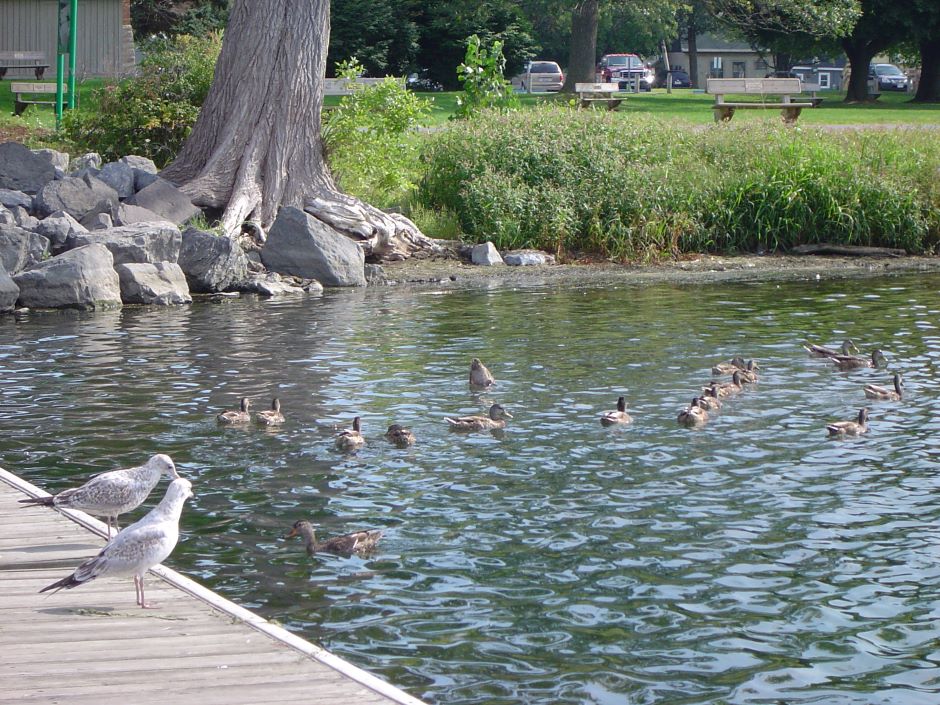Fishing in Onondaga Lake
 Ducks and Seagulls at Onondaga State Park (Credit: Sandy Taylor, CC BY-NC 2.0)
Ducks and Seagulls at Onondaga State Park (Credit: Sandy Taylor, CC BY-NC 2.0) Despite the intensive and years-long dredging projects occurring in Onondaga Lake due to toxic sediment contaminating the lake bed, anglers can and have been able to catch trophy fish in one of the previously most polluted lakes in the region. Several industrial sites along the lake contributed to the lake’s pollution in the mid-1900s, but the greatest contributor was Allied Chemical (the predecessor company to Honeywell International, Inc.).
According to Syrause.com, Allied Chemical discharged an approximate 165,000 lbs. of mercury from 1946 to 1970. Other chemicals were introduced as a result of other industrial runoff incidents from factories and treatment sites residing along the lake and its source rivers. Onondaga was plagued by pollutants for decades and was permanently changed, even with cleanup efforts.
When cleanup efforts began in 2009, Allied Chemical was tasked with leading the $451 million cleanup project, which concluded in 2016. After the sediment cap completed the cleanup initiative, the focus shifted to a restoration plan. The plan focused on making the lake healthy so locals could enjoy it once again.
Fishing in Onondaga Lake
Well, in 2022, Onondaga Lake is still struggling, but anglers have begun to make their return to the lake. Fishing continued during dredging initiatives, and most local papers reported that recreational fishing was better than expected, but as the lake continues to recover, fishing conditions have only improved.
Game fish like channel catfish, tiger musky, northern pike, walleye, common carp, largemouth bass and smallmouth bass have been caught in Onondaga Lake. While all these fish can be caught in Onondaga, there are restrictions on eating fish caught in the lake.
Due to Mercury, Dioxin, PFAS and PCB levels, all fish caught in Onondaga have consumption guidelines. Guidelines are interpreted around two groups: Men over 15 & women over 50, and women under 50 & children under 15.
Some fish, like walleye, carp, channel catfish, and white perch, are considered unsafe to eat by all interest groups. While others, such as the smallmouth and largemouth bass, brown bullhead, pumpkinseed sunfish, and others, are safe to eat 1 to 4 times a month. However, no fish caught in Onondaga Lake is safe for women under 50 or children to consume.
Conclusion
Unfortunately, Onondaga is still polluted, evident by the toxins present in aquatic life and the research showing residual contaminants in the water. Local environmentalists are hopeful that time will continue to heal the lake. After all, even if the lake isn’t entirely pollutant-free, it is the cleanest it’s been in over 100 years, according to New York’s Department of Environmental Conservation.
Still, the lake can certainly be enjoyed by recreational anglers, particularly those looking for a good catch-and-release site. Experts have even deemed the lake safe to swim in, showing that the lake is healing gradually and will perhaps one day be safe enough for every member of the community to enjoy.


Spectra Scientific
August 21, 2023 at 12:47 pm
This blog post paints a vivid picture of the unique fishing experience in Onondaga Lake. The lake’s history and revitalization efforts come to life through your words, making it more than just a fishing spot. As we cast our lines, we are also casting hope for a restored ecosystem. The insights into fishing regulations and the array of fish species add practical value to the adventure. Thanks for showcasing the beauty of Onondaga Lake while reminding us of the importance of responsible fishing and preserving its natural splendor.